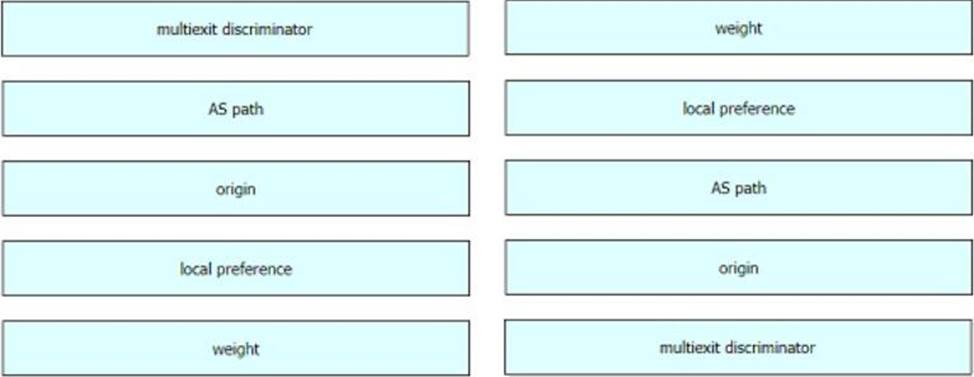Practice Free 300-510 Exam Online Questions
Refer to the exhibit.

What is the effect of this configuration?
- A . It sets the keepalive timer to 30 milliseconds and the hold timer to 240 milliseconds.
- B . It sets the keepalive timer to 30 seconds and the hold timer to 240 seconds.
- C . It sets the hold timer to 30 milliseconds and the keepalive timer to 240 milliseconds.
- D . It sets the hold timer to 30 seconds and the keepalive timer to 240 seconds.
Refer to the exhibit.

Router 1 has attempted to establish a Cisco MPLS TE tunnel to router 2, but the tunnel has failed.
Which statement about this configuration is true?
- A . Router 1 must define an explicit path to router 2
- B . Router 1 and router 2 must define the RSVP bandwidth reserved on the physical interfaces
- C . Router 2 must have a tunnel interface created with router 1 as the destination
- D . Router 1 must have Cisco MPLS TE enabled on interface gigabitethernet0/1
Level 3 switch SW1 is part of an EIGRP enabled network located at the edge of an area. Cisco Express Forwarding and SSO are enabled on the router. A network engineer must minimize the downtime of data-transmit services in the network. HSRP group 2 has already been configured with standby preempt delay minimum 2 and standby timers 140.
Which additional action must the engineer take on SW1 to suppress routing flaps for 2 minutes?
- A . Configure timers standby 2 wait 2 under the HSRP group 2 configuration.
- B . Configure timers nsf route-hold 120 under the global EIGRP configuration.
- C . Configure timers nsf signal 2 under the global EIGRP IPv4 address family.
- D . Configure timers standby 2 coverage 120 under the HSRP group 2 configuration.
Refer to the exhibit.

An engineer is troubleshooting connectivity issues on the MPLS core network. A customer connected through R4 cannot reach the OSPF domain on R5. While checking the routing table of R1, the engineer cannot see all the routes from R3 and R5.
Which task must the engineer perform so that R4 is able to reach R5?
- A . Enable OSPF peering and configure route redistribution between routers R4 and R1.
- B . Enable route filtering between routers R1 and R3.
- C . Enable MP-BGP peering on routers R1. R3, R4, and R5.
- D . Enable OSPF on the Area-0 routers and configure MP-BGP between routers R1 and R3.
Refer to the exhibit.

While troubleshooting a networking issue an engineer identified a suboptimal communication issue on route reflector RR2 In the current environment
✑ Router A is a non-route-reflector client for RR1 and RR2
✑ Routers D and E are directly connected iBGP peers.
✑ Router F is not an iBGP peer of routers D and E
Which action resolves the issue?
- A . Disable BGP Client-to-Client reflection on router RR2.
- B . Enable next-hop-self for BGP peering on router C.
- C . Remove the route-reflector configuration on router RR2.
- D . Enable next-hop-self for BGP peering on router D.
Refer to the exhibit.

A network engineer configured the redistribute connected subnets route-map filtering command on R1 to redistribute connected interfaces to the OSPF process. The engineer also wants to filter out IP address 10 0 1 0/24. but the prefix still appears in the routing tables of the other routers on the network.
Which action corrects the problem?
- A . Remove route-map sequence 30.
- B . Add a set statement to route-map sequence 20.
- C . Change the deny statement in access list 2 to permit
- D . Remove the subnets keyword from the redistribute connected subnets route-map filtering command.
What is a feature of SRGB label values?
- A . They are used for adjacency segment identifiers.
- B . They allow IS-IS and OSPF to use overlapping ranges on a domain.
- C . They are locally significant.
- D . They are assigned to segment routing nodes and have global significance throughout the domain.
Refer to the exhibit.

What is the relationship between Router 1 and Router 2?
- A . Router 1 centrally learns the topology of the network to aid in SR-TE path selection, and Router 2 is a node that feeds Router 1 topology information.
- B . Router 1 and Router 2 are participating in SR-TE tunnels and are both head-end routers.
- C . Router 1 and Router 2 centrally learn the topology of the network to aid in SR-TE path selection for peers.
- D . Router 2 is the head-end router in an SR-TE tunnel, and it is learning topology of the network from the PCE enabled on Router 1.
DRAG DROP
Drag and drop the BGP attributes from the left into the order of route selection preference on the right.


What is a requirement of PIM-SM?
- A . It requires Cisco Express Forwarding to be enabled.
- B . It must be enabled on loopback interfaces only
- C . It requires OSPF to be configured on the network.
- D . It must use an RP
